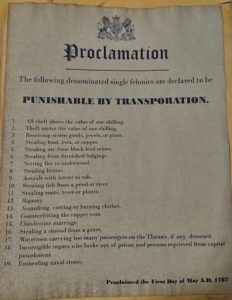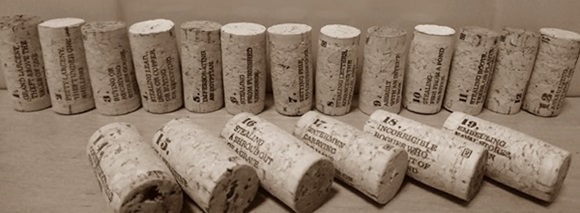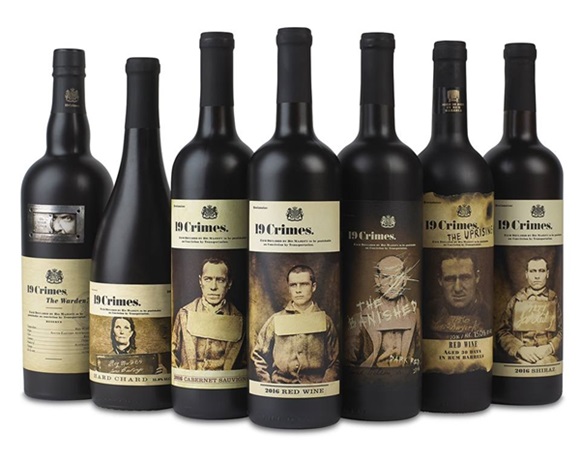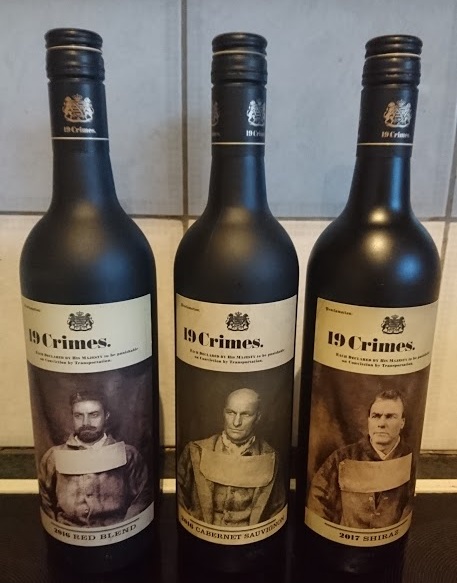History and Wine Part 2: 19 Crimes
Following on from my earlier post about convict wine, now we’re on to Part 2. And we have more history, more wine, and more convicts with “19 Crimes“.
This wine is what got me started me on the whole “convict wine” thing. And you know what … it was actually a Canadian friend who introduced me to it. Thankyou Ellen. I’ll admit I’m not a wine fanatic, but I am a history and family history buff … so anything with a convict on it is going to get my attention. So I’ve researching this wine to suss out the stories behind it all.
So it’s made in my home state of South Australia as a brand for Treasury Wine Estates, and 19 Crimes is sold locally in Australia, and overseas as well. And it was first made in 2012, so how did I not know about this until now?
So what’s so cool about 19 Crimes wine?
The Corks = The Crimes
Did you know that there were 19 reasons for transportation? No, nor did I. And each of these reasons is written on a cork. So if you’re a collector like me you wan to get the whole set. But it can be a challenge as they are added randomly you never know what you’ll get. So if you buy 2 bottles of the same wine you may get different corks, or you may get the same … you’ll never know until you open it. As a collector I’ve found it fun collecting the whole set, although I did have to bend the rules a little, since the Australian version of the wine doesn’t come with corks, but rather screwtops … so I headed to ebay, and little-by-little got the whole 19.
As a historian, it’s interesting to see this list which was proclaimed on 1st May, 1787.
The following is the list of crimes that was punishable by transportation to Australia
1. All theft above the value of one shilling
2. Theft under the value one shilling
3. Receiving stolen goods, jewels or plate
4. Stealing lead, iron or copper
5. Stealing ore from black lead mines**
6. Stealing from furnished lodgings
7. Setting fire to underwood
8. Stealing letters
9. Assault with intent to rob
10. Stealing fish from a pond or river
11. Stealing roots, trees or plants
12. Bigamy
13. Assaulting, cutting or burning clothes
14. Counterfeiting the copper coin
15. Clandestine marriage
16. Stealing a shroud from a grave
17. Watermen carrying too many passengers on the Thames, if any drowned
18. Incorrigible rogues who broke out of prison and persons reprieved from capital punishment
19. Embeuling naval stores
**Note: the 19 Crimes version of Number 5 says Impersonating an Egyptian. I’m not sure where they got that from, but it’s an odd one.
The Labels = The Criminals
Secondly the labels. There’s currently 3 convict pictures on the Australian version of the 19 Crimes wine, with 7 different ones for the overseas market (6 with convict pictures on them). However I have just had notification from the manufacturers that they are currently in the process of changing the Australian bottles to match the US ones – and will be releasing them over the course of the next year.
Treasury Wine Estates writes ..
“The men featured on our wine labels are not those of fiction. They were flesh and blood. Criminals, artists and scholars. In history, they share a bond – receiving “punishment by transportation” for violation of one of 19 crimes and becoming the first settlers of a new nation.”
So the convicts that appear on the overseas bottles (and soon to be released updated Australian bottles) of 19 Crimes are:
John Boyle O’Reilly (Red Blend)
As a youth in Ireland, John Boyle O’Reilly was a member of the Irish Republican Brotherhood, or Fenians, for which he was transported to Western Australia. After escaping to the United States, he became a prominent spokesperson for the Irish community and culture, through his editorship of the Boston newspaper The Pilot, his prolific writing, and his lecture tours.
Michael Harrington (Cabernet Sauvignon)
Convicted for his part in the well documented escape (the Catalpa Rescue) of the Militant Fenian band of convicts from Fremantle Prison, Western Australia. There’s a great article about this on the Smithsonian magazine site.
Jane Castings (Hard Chard)
Married with 4 young children, and employed as a housemaid, in 1846 Jane was sentenced to 7 years transportation for “receiving cheese and bacon knowing the same to have been stolen”.
James Wilson (The Banished)
Born James McNally in Newry, County Down, Ireland in 1836, he joined the British Army at the age of 17 (enlisting under a false name), before returning to Ireland where he became a Fenian in 1864. On 10 February 1866, he was arrested by the police who discovered him hiding in a safe house in Dublin. Wilson, along with other military Fenians were tried, found guilty of desertion and mutinous conduct, and sentenced to death. However, this sentence was later commuted to penal servitude for life, and they were transported to Western Australia. In October 1867, Wilson and sixty one other Fenians began the long sea voyage on board the Hougoumont to Australia.
Cornelius Dwyer Kane (The Uprising)
Cornelius Dwyer Kane (aka Keane) (1839-1891) had been a law clerk and cener from Skibbereen, County Cork, Ireland. Transported abroad the Hougoumont he was conditially pardoned in 1871, but was forbidden from returning to Ireland, So he never reunited with his wife and children there. He did however, settle in Queensland and became a civil servant.
James Kiely (Shiraz)
James also played a part in the “Catalpa Rescue”, which obviously didn’t go to plan. He was convicted, sent to Western Australia “for life” imprisonment, however he was granted a pardon by the King in 1905. There’s a great article on Trove about this here.
I don’t have official confirmation from Treasury Wine Estates of the names of the three convicts on the current Australian bottles. But going by the pictures I would say that Henry Singleton (alias Richard Pinches) is one of them (the one on the right in the above photo). He was transported per the ‘Lady Kennaway’. You can read more about him here.
So next time you’re out at your local bottle shop and you see 19 Crimes wine on the shelf, it’s more than just a great look and brand name, there really is a story behind each convict on the label.









Gosh, that makes wine a lot more interesting. The list of crimes which could result in transportation is very interesting. Certainly many are quite minor as has been thought. Still looking for a convict ancestor
One thing I did not see mentioned is that the labels (at least here in the US) can be scanned with an app called Living Labels and they will come to life on your smartphone.
Thanks for this post. Really curious about the person on the 2015 Cabernet Sauvignon in your picture above of the 19 crimes reds. Do you have a name or history for them. I am probably his doppelgänger and would love to research it on the off chance he is a relation. Thanks in advance 🙂
Actually, zooming in on the picture the one I’m talking about is the bearded chap on the left which says 2016 red blend, but I have also seen him used for the 2015 Cabernet. Cheers 🙂